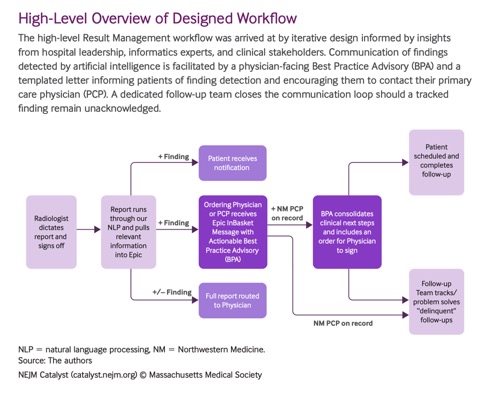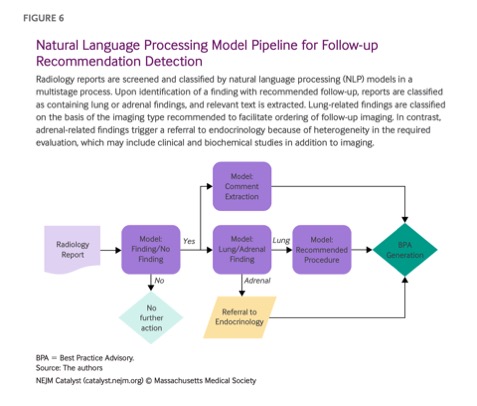Imaging Pearls ❯ Deep Learning ❯ AI and Natural Language Processing
|
-- OR -- |
|
- “Medical diagnostic imaging studies frequently detect findings that require further evaluation. An initiative at Northwestern Medicine was designed to prevent delays and improve outcomes by engineering reliable follow-up of radiographic findings. An artificial intelligence natural language processing (NLP) system was developed to identify radiology reports containing lung- and adrenal-related findings requiring follow-up. Over 13 months, more than 570,000 imaging studies were screened, of which more than 29,000 were flagged as containing lung-related follow-up recommendations, representing a 5.1% rate of lung-related findings occurrence on relevant imaging studies and an average of 70 findings flagged per day. Northwestern’s prospective clinical validation of the system, the first of its kind, demonstrated a sensitivity of 77.1%, specificity of 99.5%, and positive predictive value of 90.3% for lung findings requiring follow-up. To date, the workflow has generated nearly 5,000 interactions with ordering physicians and has tracked more than 2,400 follow-ups to completion. The authors conclude that NLP demonstrates significant potential to improve reliable follow-up to imaging findings and, thus, to reduce preventable morbidity in lung pathology and other high-risk and problem-prone areas of medicine.”
Preventing Delayed and Missed Care by Applying Artificial Intelligence to Trigger Radiology Imaging Follow-up
Jane Domingo et al.
NEJM Catalyst Vol. 3 No. 4 | April 2022 DOI: 10.1056/CAT.21.0469 - “An artificial intelligence natural language processing (NLP) system was developed to identify radiology reports containing lung- and adrenal-related findings requiring follow-up. Over 13 months, more than 570,000 imaging studies were screened, of which more than 29,000 were flagged as containing lung-related follow-up recommendations, representing a 5.1% rate of lung-related findings occurrence on relevant imaging studies and an average of 70 findings flagged per day. Northwestern’s prospective clinical validation of the system, the first of its kind, demonstrated a sensitivity of 77.1%, specificity of 99.5%, and positive predictive value of 90.3% for lung findings requiring follow-up. To date, the workflow has generated nearly 5,000 interactions with ordering physicians and has tracked more than 2,400 follow-ups to completion. The authors conclude that NLP demonstrates significant potential to improve reliable follow-up to imaging findings and, thus, to reduce preventable morbidity in lung pathology and other high-risk and problem-prone areas of medicine.”
Preventing Delayed and Missed Care by Applying Artificial Intelligence to Trigger Radiology Imaging Follow-up
Jane Domingo et al.
NEJM Catalyst Vol. 3 No. 4 | April 2022 DOI: 10.1056/CAT.21.0469 - "Considering these clinical needs, artificial intelligence (AI) is well suited to the detection and reporting of follow-up recommendations because of the large volume of imaging studies requiring screening and the relatively standardized language employed by radiologists in preparing reports. Natural language processing (NLP) methods, including text pattern-matching and traditional machine-learning techniques, have been developed for this task. In this article, we use the term traditional machine learning to refer to all machine-learning methods that are not deep learning, and these terms will be defined in detail in the sections that follow. More recently, novel deep-learning methods for NLP have shown great promise for the detection of follow-up recommendations However, methods reported to date are limited by the size of the data sets used for model training, as well as by a lack of prospective evaluation and implementation in clinical settings.”
Preventing Delayed and Missed Care by Applying Artificial Intelligence to Trigger Radiology Imaging Follow-up
Jane Domingo et al.
NEJM Catalyst Vol. 3 No. 4 | April 2022 DOI: 10.1056/CAT.21.0469 
Preventing Delayed and Missed Care by Applying Artificial Intelligence to Trigger Radiology Imaging Follow-up
Jane Domingo et al.
NEJM Catalyst Vol. 3 No. 4 | April 2022 DOI: 10.1056/CAT.21.0469
Preventing Delayed and Missed Care by Applying Artificial Intelligence to Trigger Radiology Imaging Follow-up
Jane Domingo et al.
NEJM Catalyst Vol. 3 No. 4 | April 2022 DOI: 10.1056/CAT.21.0469- “We will continue to build and test new and improved NLP models and clinical workflow adjustments. Review of model misclassifications has allowed for identification of radiology reports that may be particularly difficult to classify and retraining on updated data sets collected as part of this effort will continually improve performance. The dedicated annotation system and EHR infrastructure in place facilitate streamlined model prototyping, evaluation, and deployment. Moreover, current efforts are underway to expand this system to hepatic, thyroid, and ovarian findings requiring follow-up. Finally, as the Result Management system continues to mature and the system tracks more follow-ups to completion, we aim to further characterize its impact on patient outcomes.”
Preventing Delayed and Missed Care by Applying Artificial Intelligence to Trigger Radiology Imaging Follow-up
Jane Domingo et al.
NEJM Catalyst Vol. 3 No. 4 | April 2022 DOI: 10.1056/CAT.21.0469


